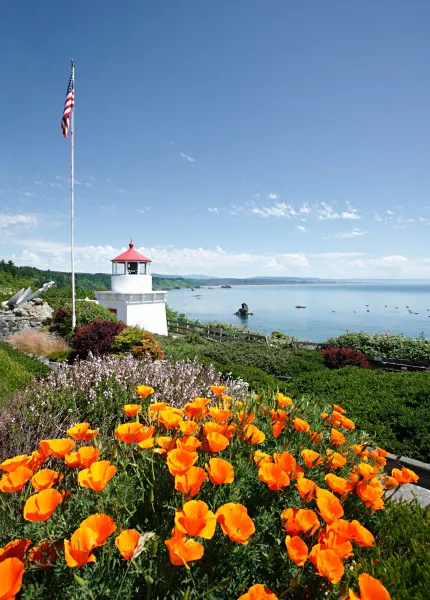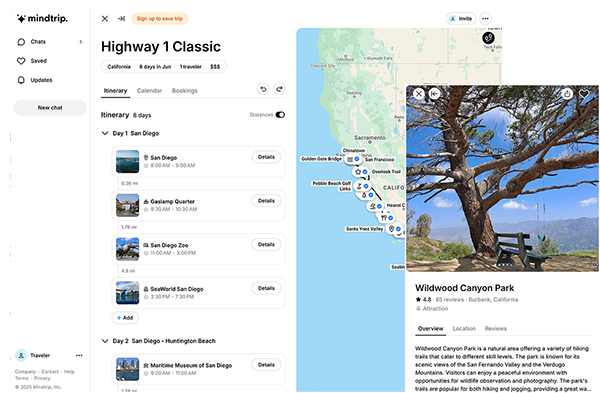Wild North Coast
Head north from San Francisco to experience solitude and a slower pace of life, with stops in Point Reyes, Mendocino, and Trinidad

Trip Itinerary Overview
9 stops on this route
Stop 1
San Francisco
Stop 2
Point Reyes National Seashore
Stop 3
Mendocino
Stop 4
Fort Bragg
Stop 5
Avenue of the Giants
Stop 6
Humboldt Redwoods State Park
Stop 7
Trinidad
Stop 8
Redwood National & State Parks
Stop 9
Crescent City
Car & RV Rentals
Trusted car & RV rental companies make your trip much easier
Discover More of California
Stop 1: San Francisco
Famous for grand-dame Victorians, classic cable cars, dynamic diversity, trend-defining, Michelin-starred cuisine, a beautiful waterfront, and a soaring crimson bridge, San Francisco, aka the “City by the Bay,” truly has it all and stands out as an ultimate must-see.
Pedal bikes across the Golden Gate Bridge and back, then explore the lush Presidio, a former military base that’s now a park, or head into Golden Gate Park to visit museums and row across a secret gem, Stow Lake. Continue along the flat Embarcadero to the bustling Ferry Building Marketplace, the Exploratorium science and learning museum, and colorful Fisherman’s Wharf.
Take a cable car ride to the mom-and-pop shops in bustling Chinatown, with a stop for a mai tai at Li Po, an old-school cocktail lounge that’s been serving up that house specialty since 1937. At night, catch a show in the theater district. For more nightlife and dining, stroll Valencia Street in the Mission, a trendy and eclectic hotbed of restaurants and bars. For more inspiration on how to get the most out of a visit to San Francisco, visit the California Welcome Center at Pier 39.
Planning Resources
- SF Travel – http://www.sftravel.com
- Top 20 Attractions in San Francisco – http://www.sftravel.com/article/top-20-attractions-san-francisco
- SF Travel: Getting Around – http://www.sftravel.com/article/how-get-around-san-francisco-transportation-basics
Stop 2: Point Reyes National Seashore
Jutting miles out into the ocean, Point Reyes National Seashore is loaded with amazing discoveries, including remarkable wildlife, deep forests, dramatic sea cliffs, and remote beaches.
No matter the time of year, there’s something extraordinary to see and do. In winter, travel to the tip of the point to look for migrating gray whales passing remarkably close. In spring, walk to Chimney Rock to see countless wildflowers, or follow a trail lined with irises into a rare Bishop pine forest. In summer, watch the fog tumble in, then have a cup of cocoa in the cozy village of Point Reyes Station. And in fall, listen for the eerie bugle of tule elk; you can usually spot individuals or small herds in the Tomales Point preserve area, at the tip of the park.
To orient yourself, stop by the Bear Valley Visitors Center, with kid-friendly displays, maps, and helpful rangers. The fairly flat, stroller-friendly Bear Valley Trail makes a popular leg-stretch or bike ride.
Planning Resources
- More About Tule Elk – http://www.nps.gov/pore/naturescience/tule_elk.htm
- Point Reyes Lighthouse – https://www.nps.gov/pore/planyourvisit/lighthouse.htm
- Point Reyes National Seashore Association – http://www.ptreyes.org
- Point Reyes National Seashore – http://www.nps.gov/pore
Stop 3: Mendocino
Mendocino is a charming North Coast hamlet, perched on a wave-carved headland, sandwiched between thick forests and a restless sea. Its dramatic location is a natural magnet for artists, and you can often see them capturing the scene on their canvases. The town is meant for walking, so stroll the streets with shops selling local artwork, then pop in for a coffee and chat with the locals. Take a walk along the bluffs, especially at sunset on fog-free evenings. Victorian-era homes, converted into B&Bs in every level of poshness, look like gingerbread houses come to life. Mendocino also knows how to throw a good party, especially when it comes to food, and annual festivals celebrate mushrooms, wine, and crab, as well as the region’s largest inhabitants, whales.
Planning Resources
- Fort Ross State Historic Park – http://www.parks.ca.gov/?page_id=449
- Mendocino Wine Country – http://www.mendowine.com/
- Visit Mendocino County – https://visitmendocino.com/
Stop 4: Fort Bragg
With its original roots as a military garrison and then a gritty lumber town, Fort Bragg skirted under the radar of most visitors. But these days, Fort Bragg has buffed up its image, with new things to see and do. There are some long-standing attractions, most notably the Skunk Train, which chugs into the redwood forests inland to the town of Willits, and Glass Beach, a rainbow of sea glass at MacKerricher State Park. Whale watching boats and fishing charters depart from rustic Noyo Harbor. But perhaps the most telling indicator of the town’s evolution is the Union Lumber Company Store at Redwood and Main. Where lumber employees used to shop for basic provisions, visitors and locals can shop at boutiques and galleries before refueling with a plate of local artisanal cheeses and a glass of Pinot Noir from a Mendocino County winery.
Planning Resources
- Visit Fort Bragg – http://www.fortbragg.com/
Stop 5: Avenue of the Giants
A drive down the 31-mile-long Avenue of the Giants is a guaranteed jaw-dropper. The narrow road snakes along one of California’s most beautiful greenbelts, a prehistoric forest featuring 2,000-plus-year-old trees. Kids love a squeeze through the privately-operated Shrine Drive-Thru Tree, and there are plenty of short hikes that are perfect for little legs. Stop in the Humboldt Redwoods State Park Visitor Center for a map and a ranger will help you choose a few groves to explore along the way. Favorites include the Immortal Tree, which has weathered floods and a lightning strike, and Founders Grove Nature Trail, where you can wrap your arms around a 325-foot-tall giant.
Planning Resources
- Avenue of the Giants – http://www.aveofthegiants.com/
Stop 6: Humboldt Redwoods State Park
Get up close to the remarkable giants of the plant world in Humboldt Redwoods State Park, and explore their emerald-green habitat. Fortunately, there are plenty of easy strolls in this 53,000-acre park—ask for suggestions at the excellent park headquarters in Weott. Avenue of the Giants runs right through the park, so you can easily turn off to explore on a variety of trails. A great way to go is to follow the Bull Creek Loop for as long as you like—the first mile or so takes in impressive trees, including those in Founders Grove, honoring the formation of Save the Redwoods League in 1918, an organization that played a critical role in the permanent protection of these remarkable trees. Or, if you’re feeling ambitious, complete the entire 7.5-mile loop, which lets you experience the remarkable Rockefeller Forest, home to the world’s 2nd, 4th, 6th, and 8th tallest trees.
Planning Resources
- Humboldt County - Explore Redwood National Park – http://redwoods.info/showrecord.asp?id=475
- California Coastal Redwoods Parks – http://www.parks.ca.gov/?page_id=24723
- Humboldt Bay Maritime Museum – http://humboldtbaymaritimemuseum.com/
Stop 7: Trinidad
Trinidad is what happens when picture-perfect headlands collide with a teacup harbor dotted with wave-sculpted sea stacks. One of Northern California’s prettiest villages, the seaside enclave makes a great base for exploring up and down the Redwood Coast or staying local and discovering under-the-radar beaches. Off Stagecoach Road, forested trails lace across the Elk Head bluffs, dropping down to secluded College Cove Beach. Sprawl on the sand and enjoy breathtaking views of tree-covered Pewetole Island and offshore sea stacks. At Sue-meg State Park (formerly Patrick's Point State Park), search for sea-polished agates and moonstones at Agate Beach, then climb to the top of Wedding Rock. Without leaving town, you can kayak around Trinidad Bay to see seabirds, seals, and tide pool creatures, or hike to the top of Trinidad Head to scan for whales. Afterward, refuel at the Lighthouse Grill with a mashed-potato waffle cone loaded with bacon and cheese. For the trip home, pack your car with smoked, line-caught seafood from Katy’s Smokehouse.
Planning Resources
- Trinidad Tourism & Lodging – http://www.trinidad-ca.com/
Stop 8: Redwood National & State Parks
Redwood National & State Parks is one of California’s crown jewels, a World Heritage Site protecting nearly half of the world’s world’s tallest trees. This spectacular network of national and state parks has dozens of paths letting you walk among soaring coast redwoods, which grow over 350 feet high. Learn about the region at the Thomas H. Kuchel Visitor Center. Ask about ranger-led walks through emerald-green Fern Canyon, or where to see majestic Roosevelt elk. (Our tip: head to Elk Meadow, or to Gold Bluffs Beach dunes, both in Prairie Creek Redwoods State Park.) Consider a guided horseback ride with the Redwood Creek Buckarettes, or ride mountain bikes with Redwood Adventures. Camping is popular here with sites in lush groves, sheltered bluffs, or wild beaches; reservations strongly advised.
Insider tip: The region is green for a reason: annual rainfall, which normally falls from October through April, averages 60 to 80 inches, so bring raingear and sturdy, nonslip shoes.
Planning Resources
- Humboldt County Visitors Bureau – https://www.visitredwoods.com/
- Thomas Kuchel Visitors Center – https://www.nps.gov/redw/planyourvisit/visitorcenters.htm
- Redwood National & State Parks – http://www.nps.gov/redw/index.htm
- California Coastal Redwoods Parks – http://www.parks.ca.gov/?page_id=24723
Stop 9: Crescent City
Crescent City is home to California’s northernmost lighthouse stations. The 1856 Battery Point Lighthouse sits on a tiny island only reachable at low tide, when visitors can walk across the causeway, climb to the lamp room for a spectacular 360-degree view. A few miles away is the lighthouse at St. George Reef, six miles offshore, built after the 1865 shipwreck of the Brother Jonathan, rumored to hold 1.5 tons of gold coins and bullion, much of which was never recovered. The lighthouse’s original Fresnel lens can be viewed at the Del Norte County Main Museum.
In town, wander the Crescent City waterfront. At Ocean World, sea lions balance balls and play catch with visitors, while at the Northcoast Marine Mammal Center, injured elephant seals and sea lions get some TLC before being released back to the wild. And Pebble Beach, on the west end of town, is a great place to search for semi-precious gemstones.
Planning Resources
- Crescent City/Del Norte County Visitor Center – https://visitdelnortecounty.com/




















